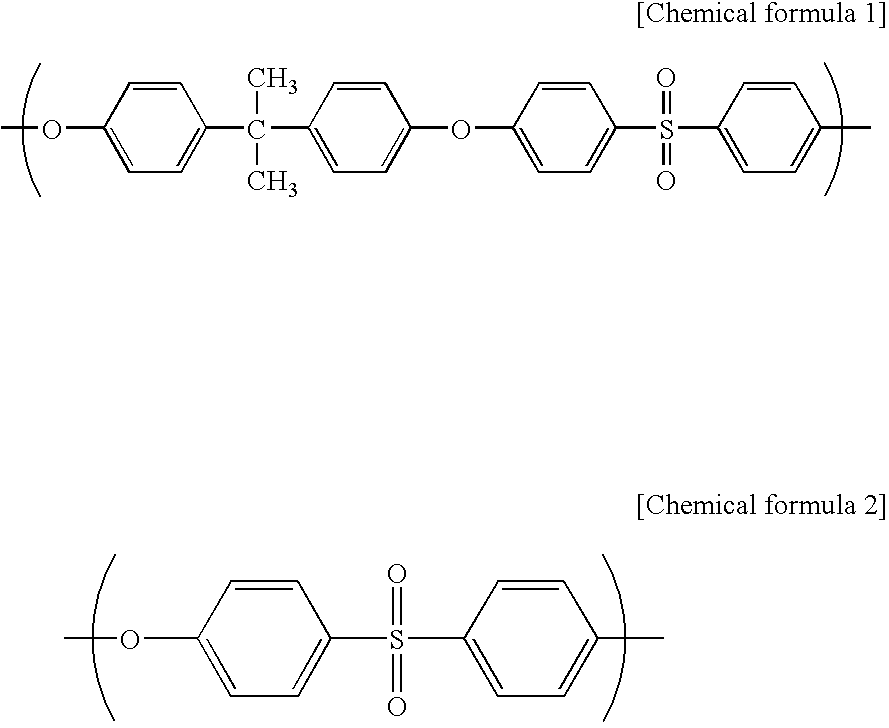Bundle of selectively permeable polysulfone-based hollow fiber membranes and process for manufacturing same
- Summary
- Abstract
- Description
- Claims
- Application Information
AI Technical Summary
Benefits of technology
Problems solved by technology
Method used
Image
Examples
example 1
[0164] Polyethersulfone (SUMIKAEXCEL® 4800P, manufactured by Sumika Chemtex Co., Ltd.) (17 mass %), poly(vinylpyrrolidone) (Kollidong® K-90, manufactured by BASF) (2.9 mass %), DMAc (77.1 mass %) and RO water (3 mass %) were homogeneously dissolved at 50° C. Then, a vacuum pump was used to decompress the interior of a system to −500 mmHg, and the system was immediately sealed so as not to change the composition of the membrane-forming solution due to the evaporation of the solvent or the like, and the system was left to stand for 15 minutes. This operation was repeated three times to degas the membrane-forming solution. The same solution was allowed to pass through a two-staged sintered filter (15 μm and 15 μm). This solution was then injected from tube-in-orifice nozzles heated to 80° C., concurrently with an aqueous solution of 55 mass % of DMAc as a hollow portion-forming material which had been previously degassed under a reduced pressure of −700 mmHg for 30 minutes. The strand ...
example 2
[0173] Polyethersulfone (SUMIKAEXCEL® 5200P, manufactured by Sumika Chemtex Co., Ltd.) (17.5 mass %), poly(vinylpyrrolidone) (Kollidon® K-90, manufactured by BASF) (3.5 mass %), DMAc (74 mass %) and water (5 mass %) were dissolved at 50° C. Then, a vacuum pump was used to decompress the interior of a system to −500 mmHg, and the system was immediately sealed so as not to change the composition of the membrane-forming solution due to the evaporation of the solvent or the like, and the system was left to stand for 20 minutes. This operation was repeated three times to degas the membrane-forming solution. The same solution was allowed to pass through a two-staged sintered filter (15 μm and 15 μm). This solution was then injected from tube-in-orifice nozzles heated to 65° C., concurrently with an aqueous solution of 55 mass % of DMAc as a hollow portion-forming material which had been previously degassed under a reduced pressure of −700 mmHg for 2 hours. The strand of the injected solut...
example 3
[0184] Polysulfone (P-3500, manufactured by AMOCO) (18 mass %), poly(vinylpyrrolidone) (K-60, manufactured by BASF) (9 mass %), DMAc (68 mass %) and water (5 mass %) were dissolved at 50° C. Then, a vacuum pump was used to decompress the interior of a system to −300 mmHg, and the system was immediately sealed so as not to change the composition of the membrane-forming solution due to the evaporation of the solvent or the like, and the system was left to stand for 15 minutes. This operation was repeated three times to degas the membrane-forming solution. The same solution was allowed to pass through a two-staged filter (15 μm and 15 μm). This solution was then injected from tube-in-orifice nozzles heated to 45° C., concurrently with an aqueous solution of 35 mass % of DMAc as a hollow portion-forming material which had been previously degassed. The strand of the injected solutions was allowed to pass through an air gap section with a length of 600 mm, sealed from an external atmosphe...
PUM
| Property | Measurement | Unit |
|---|---|---|
| Temperature | aaaaa | aaaaa |
| Fraction | aaaaa | aaaaa |
| Fraction | aaaaa | aaaaa |
Abstract
Description
Claims
Application Information
 Login to View More
Login to View More - R&D
- Intellectual Property
- Life Sciences
- Materials
- Tech Scout
- Unparalleled Data Quality
- Higher Quality Content
- 60% Fewer Hallucinations
Browse by: Latest US Patents, China's latest patents, Technical Efficacy Thesaurus, Application Domain, Technology Topic, Popular Technical Reports.
© 2025 PatSnap. All rights reserved.Legal|Privacy policy|Modern Slavery Act Transparency Statement|Sitemap|About US| Contact US: help@patsnap.com

